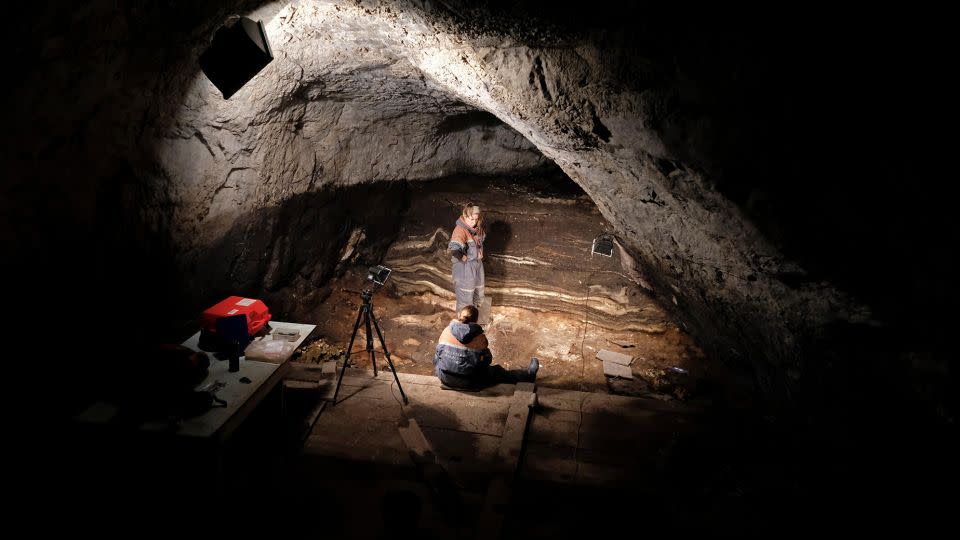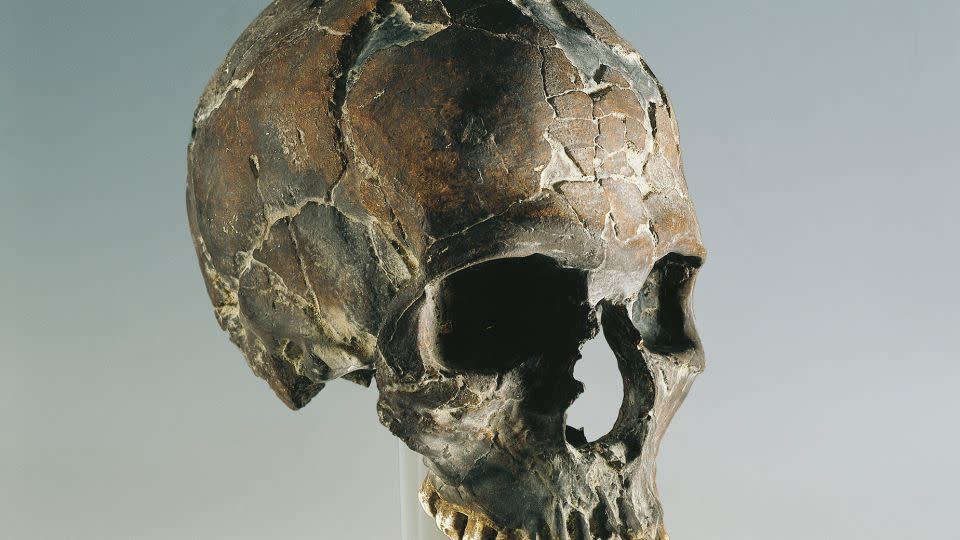Sign up for CNN’s Wonder Theory science newsletter. Explore the universe with news on fascinating discoveries, scientific advancements and more.
The 2010 discovery that early humans and Neanderthals once interbred was a scientific bombshell — the revelation of a genetic legacy that’s since been found to play a role in the lives of modern people, influencing circadian rhythms, immune system function and the way some feel pain.
Scientists, however, have found it surprisingly hard to piece together gene flow in the opposite direction: how intermingling between the two groups may have shaped Neanderthals, who went extinct around 40,000 years ago. With the help of new techniques, a new study is painting a clearer picture.
The analysis, published July 12 in the journal Science, showed that the two groups exchanged DNA at multiple points over the past 250,000 years, shedding light on how Neanderthals disappeared and potentially rewriting the story of how and when our Homo sapiens ancestors left Africa.
“To date, most genetic data suggests that modern humans evolved in Africa 250,000 years ago, stayed put for the next 200,000 years, and then decided to disperse out of Africa 50,000 years ago and go on to people the rest of the world,” said Joshua Akey, a professor at the Lewis-Sigler Institute at Princeton University and senior author of the study.
“But genetics is essentially blind to anything that doesn’t leave ancestry to present day populations. What I think (is) kind of cool about this (paper) is that it provides genetic insights into these dispersals out of Africa that we previously weren’t able to see,” Akey said.
The findings suggest that very early human history was complex, and modern humans likely interacted with Neanderthals — and other types of archaic humans, including the enigmatic Denisovans — much more frequently than previously recognized since our emergence as a species around 250,000 to 300,000 years ago.
Multiple episodes of mating
By comparing DNA sequences in databases, scientists can reconstruct relationships between different populations, or species, and because genetic changes take place at a steady rate over the course of a generation, geneticists can calculate the time elapsed between when two groups exchanged DNA — like ticks on a molecular clock.
The study found that humans left Africa, encountered and interbred with Neanderthals in three waves: One about 200,000 to 250,000 years ago, not long after the very first Homo sapiens fossils appear in Africa; another 100,000 years ago; and the last around 50,000 to 60,000 years ago.
The most recent episode is widely acknowledged and was first identified in 2010 when the first Neanderthal genome was sequenced by Nobel Prize-winning geneticist Svante Pääbo. However, the new research showed the first two waves significantly differed from that third one, a sweeping migration that ultimately led to modern humans residing in every corner of the globe.
The scientists discovered that the percentage of Homo sapiens DNA in the Neanderthal genome may have been as high as 10% more than 200,000 years ago and decreased over time; on average, it was 2.5% to 3.7%.
A similar study published last year had identified genetic traces of an encounter between the two groups around 250,000 years ago but the contribution of Homo sapiens DNA to Neanderthals around 100,000 years ago is a novel finding, said Laurits Skov, a geneticist and postdoctoral researcher at University of California Berkeley, who wasn’t involved in the study.
“What seems certain though is that human and Neanderthal history is much more interwoven than we had previously thought,” he said via email.
Genetic detective work
During the two earlier waves of interbreeding, the Neanderthal population absorbed human genes and the offspring stayed within Neanderthal groups, according to the new study.
These early mating episodes, the result of small groups of pioneering Homo sapiens migrating — but not establishing a strong foothold — out of Africa, left little record in the gene pool of modern-day human populations but did have a big impact on the Neanderthal genome, Akey said.
“I think the simplest explanation is this reflects changes in population sizes over time,” he added.
“At first, (early) modern humans were trickling out of Africa, and Neanderthal populations were large enough that they were able to essentially absorb these initial dispersals of humans and their genes into the Neanderthal population,” Akey explained.
However, when Homo sapiens left Africa around 60,000 years ago in a lasting migration around the world, the offspring resulting from Homo sapiens-Neanderthal encounters grew up within modern human populations and their genetic signature remained within the human gene pool, influencing our lives today, he added.
In the study, the team used machine learning techniques to decode and sequence genomes from the remains of three Neanderthals, which dated from 50,000 to 80,000 years ago and were found in three different locations: Vindija, Croatia, and Denisova and Chagyrskaya caves in the Altai Mountains. The researchers then compared that data with the genomes of 2,000 present-day humans.
“We developed a framework to determine if human to Neanderthal gene flow occurred, estimate how much modern human sequence are in Neanderthal genomes, and identify the specific places in the Neanderthal genome that are carrying …modern human sequences,” Akey said.

Mystery of Neanderthals’ disappearance
There are a handful of Homo sapiens fossils that may reflect the species’ early, less successful, journeys out of Africa into the Middle East and Europe, said Chris Stringer, research lead in human evolution at the Natural History Museum in London, who wasn’t involved in the study.
These relics include a Homo sapiens fossil found in Apidima Cave in southern Greece dated back to 210,000 years ago and remains found at Israeli sites Skhūl and Qafzeh. The fossils found in Israel had “primitive traits,” such as larger brows, flatter skulls and variable chins.
“I’ve interpreted (these) traits (as) retained from more primitive non-Neanderthal ancestors, but they could alternatively be signs of gene flow from Neanderthals, and perhaps such characteristics should be looked at again now, in the light of this new work,” Stringer said.


The population dynamics identified in this research could be a major reason why Neanderthals disappeared 40,000 years ago, Akey noted. The researchers’ analysis suggests that the Neanderthal population size at the time was 20% smaller than previously thought.
“Human populations were larger, and like waves crashing on the beach, eventually eroded the Neanderthals,” with the Neanderthal gene pool likely absorbed into the human population in the last wave of interbreeding, Akey said.
“Extinction is complicated, so I think I would be hesitant to say it’s the only explanation … but I think the absorption of Neanderthals in human populations likely explains a significant amount of why the Neanderthals disappeared,” he added.
Stringer said he agreed that the last phase of interbreeding may have contributed to Neanderthal extinction, with the Neanderthal population getting even smaller and less diverse as Neanderthal DNA entered the larger human gene pool.
“I think that is an important point,” Stringer said. “Factoring out the increase in Neanderthal genetic diversity from interbreeding with sapiens also significantly reduces their effective population size, adding further evidence that the late Neanderthals might already have been an endangered species even without competition from an expanding Homo sapiens population.”
For more CNN news and newsletters create an account at CNN.com
Source Agencies


